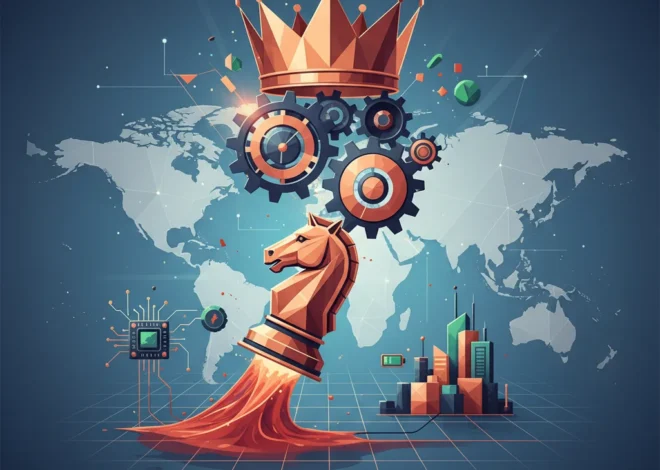
AI: The New Economic Engine Fueling Global Growth Against All Odds
In the world of economics, forecasts are a fragile business. For months, the consensus pointed towards a global slowdown, a cooling-off period after years of unprecedented stimulus and inflationary pressures. Yet, the latest data reveals a plot twist worthy of a blockbuster, and the unlikely hero is a force that is simultaneously reshaping our future: Artificial Intelligence.
The International Monetary Fund (IMF), in its recent World Economic Outlook, has upgraded its forecast for global growth, citing a surprising and powerful engine keeping the world’s largest economy from stalling. That engine is the United States, which is demonstrating remarkable resilience, largely shielded from a sharp downturn by a colossal boom in AI-related investing. This surge in capital, combined with robust consumer spending, is not just propping up the US but is sending positive ripples across the entire global economy.
However, the IMF’s report is not a clean bill of health. It’s a complex diagnosis, highlighting a growing divergence between the booming US and its more sluggish counterparts in Europe and China. It also waves a red flag over persistent inflation and the rising threat of trade tariffs, which could unravel this fragile stability. Let’s dissect the IMF’s findings and explore what this AI-fueled landscape means for investors, business leaders, and the future of global finance.
The American Anomaly: How AI is Defying Economic Gravity
The headline story from the IMF is the upward revision of global growth to 3.2 per cent for 2024, a modest but meaningful improvement. The driving force behind this optimism is the stellar performance of the US economy, now projected to grow at 2.7 per cent this year—a significant upgrade from previous estimates. This strength stems from two primary pillars:
- The Resilient American Consumer: Despite the highest interest rates in decades, US consumers have continued to spend. A strong labor market, wage growth, and lingering pandemic-era savings have provided a powerful buffer, keeping demand high for goods and services.
- The AI Investment Supercycle: This is the game-changer. The explosive growth in generative AI has triggered a tidal wave of corporate investment. This isn’t just about software; it’s a tangible, physical expansion. Companies are pouring billions into building massive data centers, purchasing high-end semiconductors, and expanding their cloud infrastructure. This activity directly boosts GDP, creates high-skilled jobs, and has sent the tech-heavy stock market to new heights. According to the IMF, this powerful private investment is a key reason for the US economy’s outperformance (source).
This AI boom is a classic example of how technological innovation can have profound macroeconomic effects. It’s creating a virtuous cycle: excitement about AI’s potential drives stock valuations higher, which in turn allows companies to raise capital more easily to fund further investment, fueling real economic growth.
A World Divided: The Great Economic Divergence
While the US powers ahead, the global picture is far from uniform. The IMF report paints a stark picture of economic divergence, where the world is splitting into distinct lanes of growth. This creates both opportunities and significant risks for international trade and investment.
Here’s a snapshot of the IMF’s revised growth forecasts for major economic blocs, illustrating the growing gap:
| Region/Country | 2024 Growth Forecast (IMF) | Key Economic Factors |
|---|---|---|
| United States | 2.7% | Strong consumer demand, massive AI investment. |
| Eurozone | 0.8% | Weakness in Germany, lingering effects of the energy crisis. |
| China | 4.6% | Ongoing property sector crisis, weak consumer confidence. |
| Emerging & Developing Economies | 4.2% | Strong performance from countries like India and Brazil. |
This divergence has critical implications. For multinational corporations, it means rethinking supply chains and market focus. For investors, it complicates asset allocation, as currency fluctuations and regional economic policies can drastically impact returns. The Eurozone, particularly its industrial heartland Germany, continues to struggle with the aftershocks of the energy crisis and sluggish global demand. Meanwhile, China’s economy is grappling with a deep-seated crisis in its property market, which has dampened consumer and investor confidence (source). This stark contrast with the US highlights a multi-speed world that will define the next phase of the global economy.
Still, we must ask the hard questions. What happens when the initial infrastructure build-out slows? Can the promised productivity gains truly justify the trillions in market value that have been created? The real test will be whether AI transitions from a capital-intensive build-out phase to a productivity-enhancing utility across the entire economy. For now, it’s providing a powerful, and perhaps temporary, shield against recession. Investors should celebrate the gains but remain acutely aware that the line between a technology revolution and a speculative mania can be razor-thin.
Lurking Dangers: Inflation, Tariffs, and the Policy Tightrope
Despite the upgraded outlook, the IMF’s chief economist, Pierre-Olivier Gourinchas, cautions that “plenty of challenges” remain. The path forward is riddled with obstacles that could easily derail the current momentum.
The Return of “Pass-Through” Inflation
One of the most significant warnings concerns the impact of trade tariffs. For years, the costs of tariffs, particularly in the US-China trade war, were largely absorbed by producers, who compressed their profit margins to keep consumer prices stable. The IMF now warns this buffer is gone. New research suggests that there is now a much more direct “pass-through” of tariff costs to import prices and, ultimately, to consumers. With import prices rising almost one-for-one with tariffs, any escalation in trade disputes could quickly translate into higher inflation.
This is a critical risk for central banks. Institutions like the Federal Reserve are walking a tightrope, trying to guide inflation back to its 2% target without crushing economic growth. A new wave of cost-push inflation from tariffs would complicate this task immensely, potentially forcing them to keep interest rates higher for longer.
The Role of Financial Technology in Fueling the Future
The AI boom is not happening in a vacuum. It is being enabled and accelerated by a sophisticated global finance ecosystem, where financial technology, or fintech, plays a pivotal role. The trillions of dollars required for this technological build-out are allocated through complex capital markets, and fintech innovations are making this process more efficient than ever.
From a trading perspective, advanced algorithmic platforms are being used to manage vast investment portfolios and execute trades in AI-related stocks with precision. In the world of banking, AI itself is being used to underwrite loans for tech startups and assess the risk of large-scale infrastructure projects. Furthermore, retail investing platforms have democratized access to the stock market, allowing individuals to participate directly in the growth of AI leaders.
Looking ahead, emerging technologies like blockchain could also play a role, potentially offering secure and transparent ways to manage the vast datasets that power AI models or to track complex, multi-party investments in new tech ventures. The synergy between AI and financial technology is creating a powerful feedback loop that is fueling this new economic cycle.
Conclusion: Navigating a Landscape of Opportunity and Risk
The global economy stands at a fascinating crossroads. The narrative has shifted from an impending slowdown to a story of surprising resilience, largely authored by the American consumer and the transformative power of AI investment. The IMF’s latest report confirms that technology is once again acting as a primary catalyst for economic growth, creating opportunities for investors and businesses worldwide.
However, this is a moment for clear-eyed optimism, not blind euphoria. The risks are real and significant. The economic divergence between major regions, the persistent threat of inflation, and the specter of escalating trade wars could easily fracture this fragile stability. For investors, the key is to look beyond the hype and focus on fundamentals, while diversifying across regions to mitigate the risks of a multi-speed world. For business leaders, the mandate is twofold: embrace the productivity gains offered by AI while building resilient supply chains that can withstand geopolitical shocks.
The AI boom has provided the global economy with a powerful, unexpected tailwind. The challenge now is to navigate the turbulence ahead and harness this technological revolution to build a foundation for sustainable, long-term growth.


